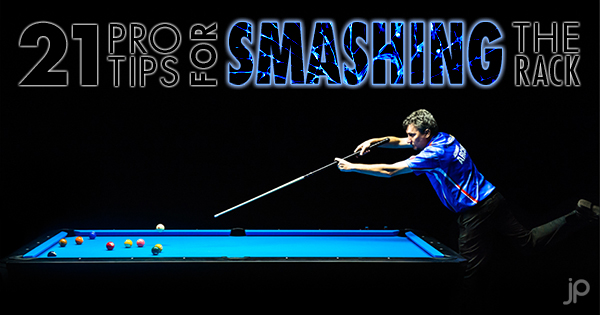
The break happens at the beginning of every game, and might just be the most important shot of any match. It’s not just about having the right equipment (although choosing the best break cue does help), but having the correct technique to shatter the rack. Properly executing a solid break shot can be the difference between winning and losing, so knowing how to maximize your opportunities is essential. Over the years we’ve asked a lot of professionals, like Thorsten Hohmann, Johnny Archer, and Jeanette Lee, what they think is the key to a dominating break shot, and we’ve compiled a list of some of the best tips, tricks, and secrets.
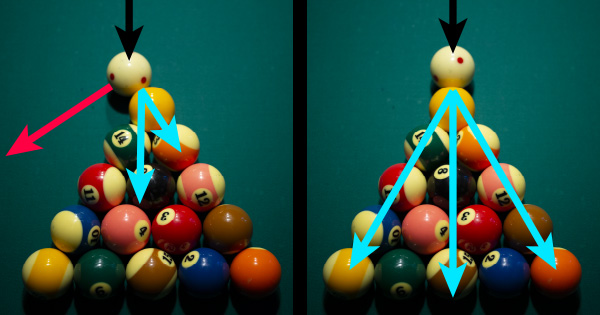
1. Don’t sacrifice accuracy for power.
These two aspects are intimately related. The number one rule in breaking is to hit the head ball - almost always the 1 ball - as fully as possible. An accurate, dead-center hit will transfer all of the ball's momentum - i.e., power - into the rack. "It's like hitting a golf ball," says Johnny Archer. "If you hit a golf ball at dead-center at 105 mph, you are going to hit it just as far as somebody swinging at 120 mph and hitting it off center. In pool, if you hit the 1 ball at dead-center, you don't have to hit them as hard to get the action."
 Frank Says: The easiest way to improve your break is with your own dedicated break cue! Break cues have stiffer shafts and harder tips that are designed to maximize power transfer and will increase your chances of making balls on the break!”
Frank Says: The easiest way to improve your break is with your own dedicated break cue! Break cues have stiffer shafts and harder tips that are designed to maximize power transfer and will increase your chances of making balls on the break!”
2. Be flexible.
In the end, the only good break shot is the one that sinks a ball, so be prepared to be flexible and adjust your strategy. That could mean switching cue ball positions, changing speeds, or even trying a less-than-full hit on the head ball (in extreme situations). For example, "some people refuse to soft break because they are stubborn," says Thorsten Hohmann. "They think, 'I have to break hard.' But you want to win."
3. Watch your sidespin.
Avoid using too much left or right hand English. You want to keep the cue ball from scratching, and side English will impel the cue ball to dance around the table until it falls drunkenly into a pocket. Some pros may use a hair of left or right if they're consistently scratching on otherwise solid breaks (for example, “a little left if you're always scratching in the right side pocket,” says Shawn Putnam), but they're professionals.
4. Sharpen your stance.
Some experts suggest narrowing your stance, which helps if you plan on propelling your hips and torso forward on the break stroke. Most pros favor their front foot on the break, and it's a good idea to stand more upright than you would on a regular shot, but make sure you still keep your legs bent. That will help you generate momentum. Everybody has their own interpretation of these principles, and you can see Thorsten Hohmann's down below.
5. Choose your spot wisely.
Every table breaks differently, but there are a few ways to find the sweet spot in a hurry. First, check the cloth for tell-tale signs of wear. Previous players may have found the best cue-ball position for the break, so you should see marks for that position, and streaks leading to the foot spot. Second, if you know your table ahead of time, check out an earlier match to see where the players are breaking and what speed seems to be working.
6. Watch where the pros start.
Unless the rules mandate breaking from the box, most pros start breaking from a point a few inches from either the left or right rail. Depending on the result, they could move in a few more inches, which usually will affect the path of the 1 ball as it flirts with the side pocket (and the wing balls to a varying degree). Another option is to switch sides and/or the speed of your stroke.
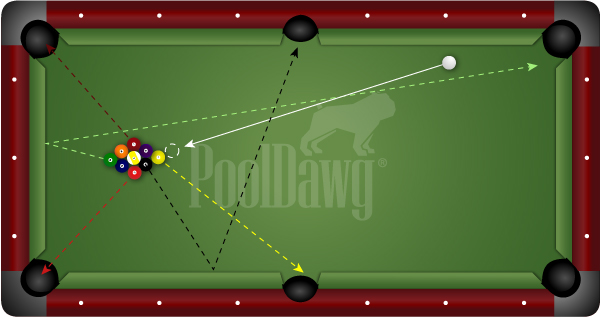
7. Know the 9-ball object paths.
This a map of the tendencies of the object balls on a 9-ball break. Obviously, these are best-case scenarios. The key balls to watch are the head ball (1 in the photo) and the wing balls (7 and 3), as they are the most reliable. Expert players will adjust the position of their cue ball along the headstring, and/or the speed of their break, until they can reliably sink one or more of these balls.
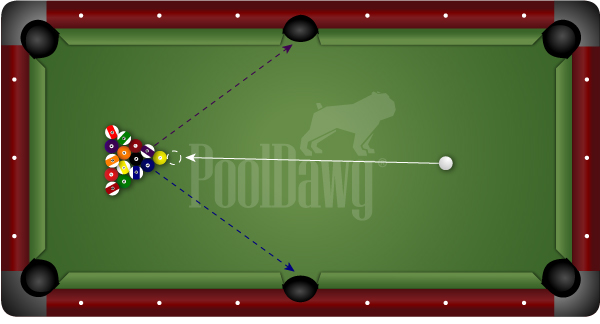
8. Know the 8-ball object paths.
Obviously, the 8-ball break is more complex than the 9-ball break, so it's difficult to control any of the object balls with any precision. But we do know that your best friends are the two balls after the head ball, which tend to meander toward their respective side pockets.
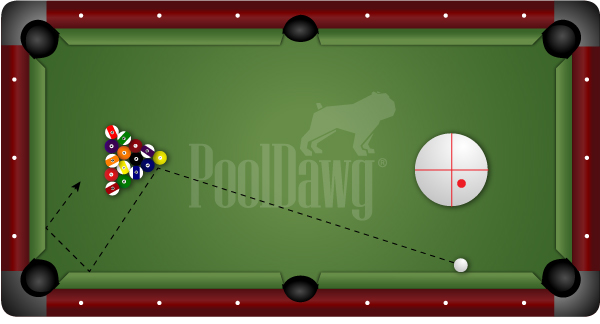
9. Know the rules of your match.
Billiards Digest 8-ball guru Larry Schwartz recommends using another strategy if the rules say you win by sinking the 8 on the break. (Some rules call for spotting the 8.) In this circumstance, hit the second ball as fully as possible, either from the right or left. Strike the cue ball with low right English if you are breaking from the left, and use low left if you are breaking from the right. The English helps to keep you from scratching. This break helps propel the 8 from the pack toward the pockets. This is a high-risk/ high-reward breaking style, and can often result in poor spreads and lots of clusters.
10. Make solid contact.
In 8-ball, it's crucial to make a solid hit with the energy of the stroke directed straight into the head ball and rack, so many pros break within the first diamond from center (left or right).
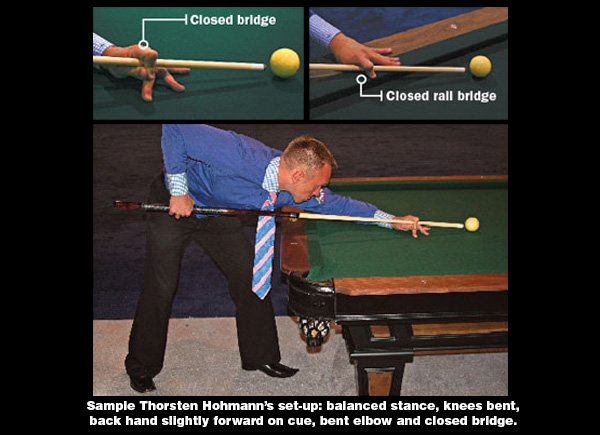
11. Use a closed bridge.
Whether you're breaking from the rail or the center of the table, you want to use a closed bridge. You'll have more accuracy on your cue-ball hit, and the closed bridge will help you keep the tip down as your body rises up. "I put a little pressure on my bridge hand so I don't raise up," says Stevie Moore. "I'll lean on it a little bit."
12. Keep your bridge arm loose.
It should be relaxed and bent at a slight angle. If it's straight and stiff, it will inhibit your body on the backswing and keep your body from moving into the shot.
13. Mind your bridge distance.
A lot of pros set up a bit farther away than normal on the break shot - maybe 8 or 10 inches. "You have to take it back farther on the backswing, and you follow-through so much that you need to make more room," says Johnny Archer. The extra distance certainly allows for more acceleration on your stroke. (If you're bridging from the rail, the distance will tend to be shorter.) But be careful: the longer the bridge distance, the less accurate your stroke will tend to be.
14. Find your perfect back hand position.
There's a lot of debate over whether you should reach a few inches farther back on the pool cue for your break shot - giving you a longer stroke - or to keep your back hand in its usual position. Experiment, and go with what's comfortable. For the record, Thorsten Hohmann actually chokes up a few inches for the break for more control. Jeanette Lee also chokes up the cue during her break shot.
15. Strike the cue ball in the center.
It's nearly unanimous: You should contact the cue ball a hair to a full tip below center. The point is to squat the cue ball at the middle of the table once it hits the head ball. The backspin that you're applying will dissipate after the collision, leaving the cue ball with no locomotion. But be careful: A lot of folks aim low, but their cues creep up on the break stroke.
16. Dial in your backswing.
"I've always had problems with my break," says Jeanette Lee. "There are many different techniques that people use, but the universal commonality between them is the slow backswing. On your last stroke, pull the cue back in a controlled motion, and then start forward smoothly and accelerate." Think of it as pulling back the string of a bow before launching an arrow.
17. Keep your eye on the ball.
There are two schools of thought on your focus point during the break stroke. Some players recommend looking at the rack's head ball, and other's keep focused on the cue ball to ensure an accurate hit. "I've been trying to look at the 1 ball, and it's pretty tough for me," says Stevie Moore. "I've always looked at the cue ball. I kind of glance back and forth, but my last look has been at the cue ball. I can't really control it. A lot of good players look at the 1 ball. It's hard. You have to really trust your stroke."
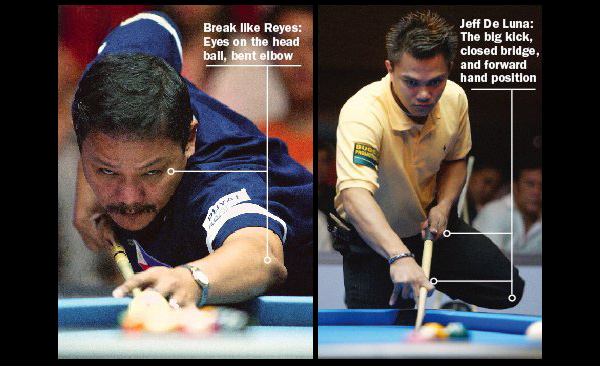
18. Transfer your weight on contact.
Many of the biggest breakers propel their hips and torsos forward as they're starting their stroke, usually ending in a kick from the back foot (see photo of Jeff DeLuna). Their weight ends up on the front foot. "You're using your legs to give your arm and stroke more speed and momentum," says Charlie Williams. "Try to focus on using your back leg to generate forward power. And that makes your back leg naturally kick higher." One tip to try out: Think of it as a martial arts move, kicking someone who's standing right in back of you.
19. Practice your timing.
It's the key ingredient and the most mysterious element of a successful break. In essence, you're trying to get several body parts to work together in a movement that takes less than a second. In the end, go with what works for you. But, in a nutshell, here is the progression that most experts suggest: Finish your backswing, pause, start pushing your hips and torso forward, start a smooth acceleration of the cue, strike the cue ball and then follow-through as your back foot leaves the floor.
20. Keep your cue level.
Ideally, at the moment your cue tip hits the cue ball, you want your forearm to be perpendicular (at a 90-degree angle) to your cue. "You're in the middle of the range of motion," says Shawn Putnam. "You've started accelerating, but you're not running out of stroke yet." And keep the cue as level as you are comfortable; too much pitch, and the cue ball could jump off the table.
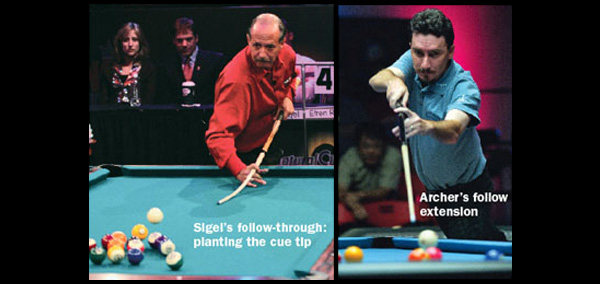
21. Develop a strong follow through.
After initially hitting the cue ball, the cue should keep moving forward. Since the cue is descending into the shot at a short angle, it's only natural that the cue tip should hit the cloth after the point of contact and continue sliding uptable. Some players, such as Mike Sigel and Thorsten Hohmann, actually plant their cue sticks at the end of the follow-through, and you can see the shaft bending at the end of the stroke. This shaft bending is not recommended as it puts unusual directional stress on joints and shafts and can cause out-of-warranty damage. The guys with the most exaggerated follow-throughs, such as Johnny Archer and Francisco Bustamante, travel past that point until their cues are aloft and frozen in a sort of "Hustler"-meets-Heisman pose.
There are no shortcuts in pool, and there’s no substitution for working hard and practicing every single day. But if you take these tips to heart, you’ll start seeing dramatic improvements in your break. Dramatic improvements in your break give you more opportunities to shoot and to win!
Special thanks to JP Parmentier for letting us use the title image with Johnny Archer’s break shot. Do yourself a favor and follow JP on Facebook and Instagram (@jpparmentier) for the BEST photos of the professional billiard scene!